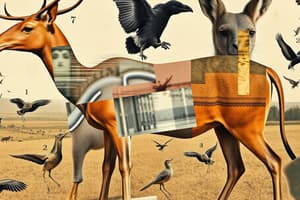Podcast
Questions and Answers
¿Cuál de los siguientes es un nivel de clasificación taxonómica?
¿Cuál de los siguientes es un nivel de clasificación taxonómica?
- Género (correct)
- Adverbio
- Conjunción
- Verbo
Los mamíferos poseen escamas.
Los mamíferos poseen escamas.
False (B)
¿Cuál de los siguientes animales es un ave?
¿Cuál de los siguientes animales es un ave?
- Delfín
- Elefante
- Salamandra
- Pingüino (correct)
Los __________ son vertebrados caracterizados por la presencia de branquias.
Los __________ son vertebrados caracterizados por la presencia de branquias.
¿Qué es la biodiversidad?
¿Qué es la biodiversidad?
La deforestación es un factor que contribuye a la pérdida de biodiversidad.
La deforestación es un factor que contribuye a la pérdida de biodiversidad.
Relacione los siguientes grupos de animales con sus características:
Relacione los siguientes grupos de animales con sus características:
¿Cuál de las siguientes es una estrategia de conservación?
¿Cuál de las siguientes es una estrategia de conservación?
Flashcards
Animal Kingdom
Animal Kingdom
A group of multicellular, eukaryotic organisms that are heterotrophic and typically mobile.
Sexual Reproduction
Sexual Reproduction
The process of producing offspring through the fusion of gametes (sperm and egg).
Classification of Organisms
Classification of Organisms
Systematic arrangement of organisms in hierarchical levels based on shared characteristics and evolutionary relationships.
Phylogeny
Phylogeny
Signup and view all the flashcards
Habitats
Habitats
Signup and view all the flashcards
Biodiversity
Biodiversity
Signup and view all the flashcards
Biodiversity Loss
Biodiversity Loss
Signup and view all the flashcards
Conservation Efforts
Conservation Efforts
Signup and view all the flashcards
Mammals
Mammals
Signup and view all the flashcards
Invertebrates
Invertebrates
Signup and view all the flashcards
Study Notes
Reino Animal
- The animal kingdom encompasses a vast array of organisms, characterized by features like eukaryotic cells, multicellularity, heterotrophic nutrition, and typically active movement.
- Animals reproduce sexually, with a wide variety of reproductive strategies.
- They exhibit diverse body plans, ranging from simple invertebrates to complex vertebrates.
- Cells are specialized for various functions, leading to tissue, organs, and organ systems.
- Animals are dependent on other organisms for food.
Clasificación De Seres Vivos
- The classification of living organisms, including animals, is structured hierarchically (e.g., domain, kingdom, phylum, class, order, family, genus, species).
- This hierarchical structure reflects evolutionary relationships.
- Each taxonomic level represents a broader group of organisms sharing specific characteristics.
- Modern classification systems often incorporate phylogenetic data (evolutionary relationships) alongside traditional morphological characteristics.
Hábitats Y Ecosistemas
- Animals inhabit diverse habitats across the globe, from terrestrial environments to aquatic ecosystems.
- Terrestrial habitats include forests, grasslands, deserts, and mountains.
- Aquatic habitats encompass oceans, rivers, lakes, and wetlands.
- Each habitat supports unique animal communities adapted to specific environmental conditions.
- Environmental factors, like temperature, water availability, and sunlight, significantly influence animal distribution and abundance.
- Ecosistemas are complex interactions between living organisms (biotic factors) and their non-living environment (abiotic factors).
Biodiversidad Y Conservación
- Biodiversity refers to the variety of life on Earth, encompassing genetic diversity, species diversity, and ecosystem diversity.
- Animal diversity is a critical component of overall biodiversity.
- Human activities are a major driver of biodiversity loss, threatening numerous animal species.
- Habitat destruction, pollution, climate change, and overexploitation are key factors reducing biodiversity.
- Conservation efforts aim to protect and preserve biodiversity, including animal species.
- Conservation strategies include establishing protected areas, combating pollution, and promoting sustainable practices.
- Biodiversity has both ecological and economic value for supporting ecosystem services.
Relacionar ejemplos
- Mamíferos: Humans ( Homo sapiens ), elephants ( Elephantidae ), dolphins ( Delphinidae ). Mammals are characterized by mammary glands for milk production and typically have fur or hair.
- Aves: Penguins ( Spheniscidae ), eagles ( Accipitridae ), hummingbirds ( Trochilidae ). Birds are characterized by feathers, wings, and the ability to fly (although some, like penguins, have adapted for different lifestyles).
- Reptiles: Snakes ( Serpentes ), lizards ( Squamata ), turtles ( Testudines ). Reptiles are characterized by scales, a dry skin, and usually lay eggs.
- Anfibios: Frogs ( Anura ), salamanders ( Caudata ), toads ( Bufonidae ). Amphibians are characterized by a life cycle that often involves aquatic and terrestrial stages, generally having moist skin and relying on water for reproduction.
- Peces: Salmon ( Salmonidae ), sharks ( Selachii ), goldfish ( Carassius auratus). Fish live in water and have gills to breathe and fins for movement.
- Invertebrados: Insects ( Insecta ), spiders ( Araneae ), mollusks ( Mollusca ). Invertebrates encompass a vast group characterized by lacking a backbone, exhibiting remarkable diversity.
- Ejemplos de interacciones ecológicas: Predation (a lion hunting a zebra), competition (two species competing for the same resources), symbiosis (a bee and a flower).
- Ejemplos de conservación: Establishing national parks to protect endangered species, reducing pollution to safeguard water and air quality, and promoting sustainable agriculture.
Studying That Suits You
Use AI to generate personalized quizzes and flashcards to suit your learning preferences.




